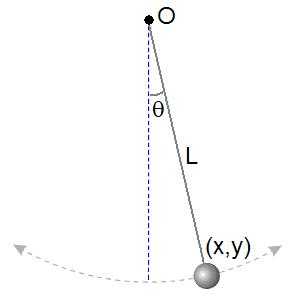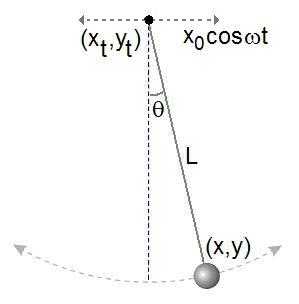Rheonomous
A mechanical system is rheonomous if its equations of constraints contain the time as an explicit variable.[1][2] Such constraints are called rheonomic constraints. The opposite of rheonomous is scleronomous.[1][2]
Example: simple 2D pendulum

As shown at right, a simple pendulum is a system composed of a weight and a string. The string is attached at the top end to a pivot and at the bottom end to a weight. Being inextensible, the string has a constant length. Therefore this system is scleronomous; it obeys the scleronomic constraint
-
 ,
,
where  is the position of the weight and
is the position of the weight and  the length of the string.
the length of the string.

The situation changes if the pivot point is moving, e.g. undergoing a simple harmonic motion
 ,
,
where  is the amplitude,
is the amplitude,  the angular frequency, and
the angular frequency, and  time.
time.
Although the top end of the string is not fixed, the length of this inextensible string is still a constant. The distance between the top end and the weight must stay the same. Therefore this system is rheonomous; it obeys the rheonomic constraint
 .
.
See also
References
- ↑ 1.0 1.1 Goldstein, Herbert (1980). Classical Mechanics (2nd ed.). United States of America: Addison Wesley. p. 12. ISBN 0-201-02918-9. "Constraints are further classified according as the equations of constraint contain the time as an explicit variable (rheonomous) or are not explicitly dependent on time (scleronomous)."
- ↑ 2.0 2.1 Spiegel, Murray R. (1994). Theory and Problems of THEORETICAL MECHANICS with an Introduction to Lagrange's Equations and Hamiltonian Theory. Schaum's Outline Series. McGraw Hill. p. 283. ISBN 0-07-060232-8. "In many mechanical systems of importance the time t does not enter explicitly in the equations (2) or (3). Such systems are sometimes called scleronomic. In others, as for example those involving moving constraints, the time t does enter explicitly. Such systems are called rheonomic."